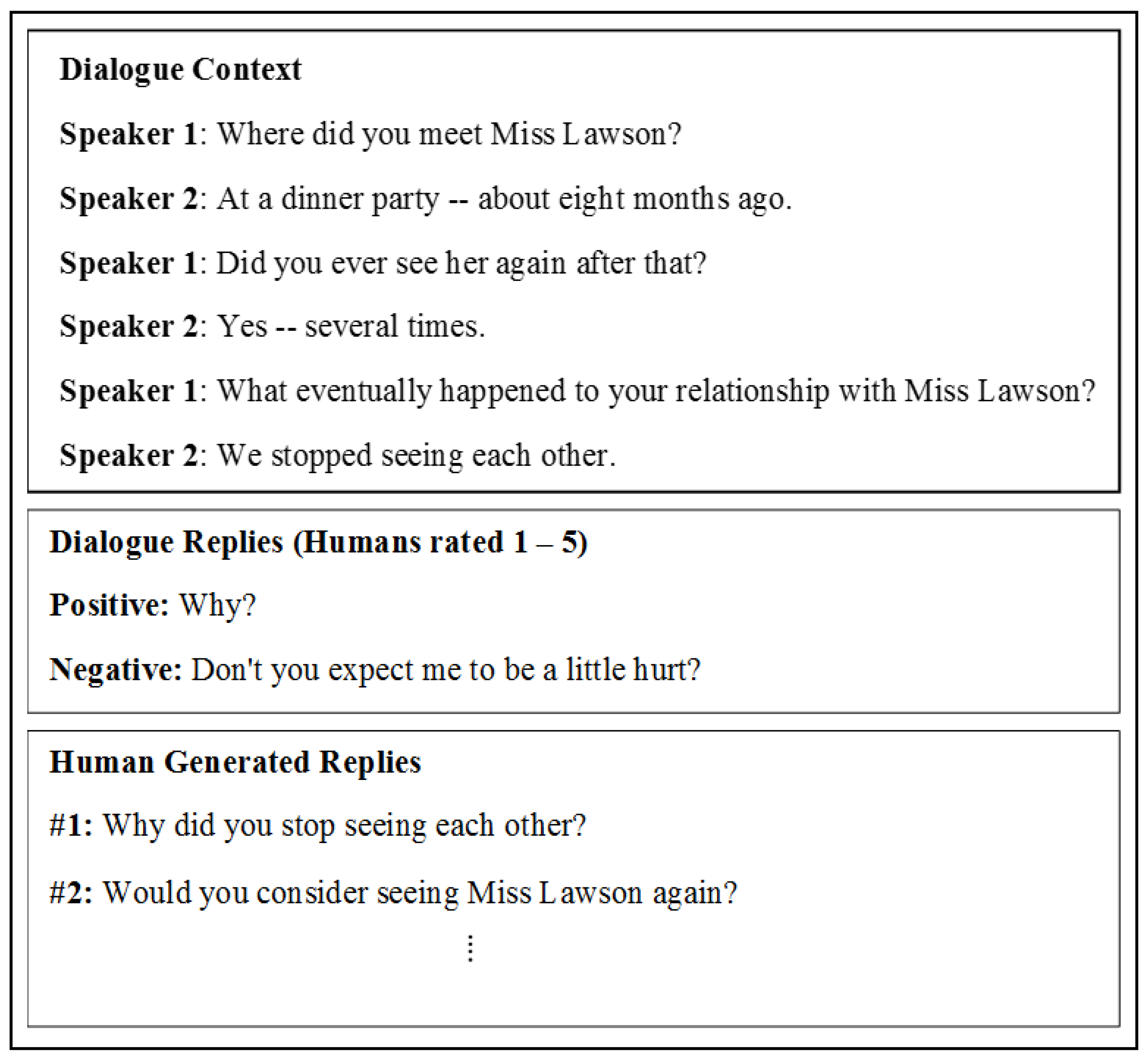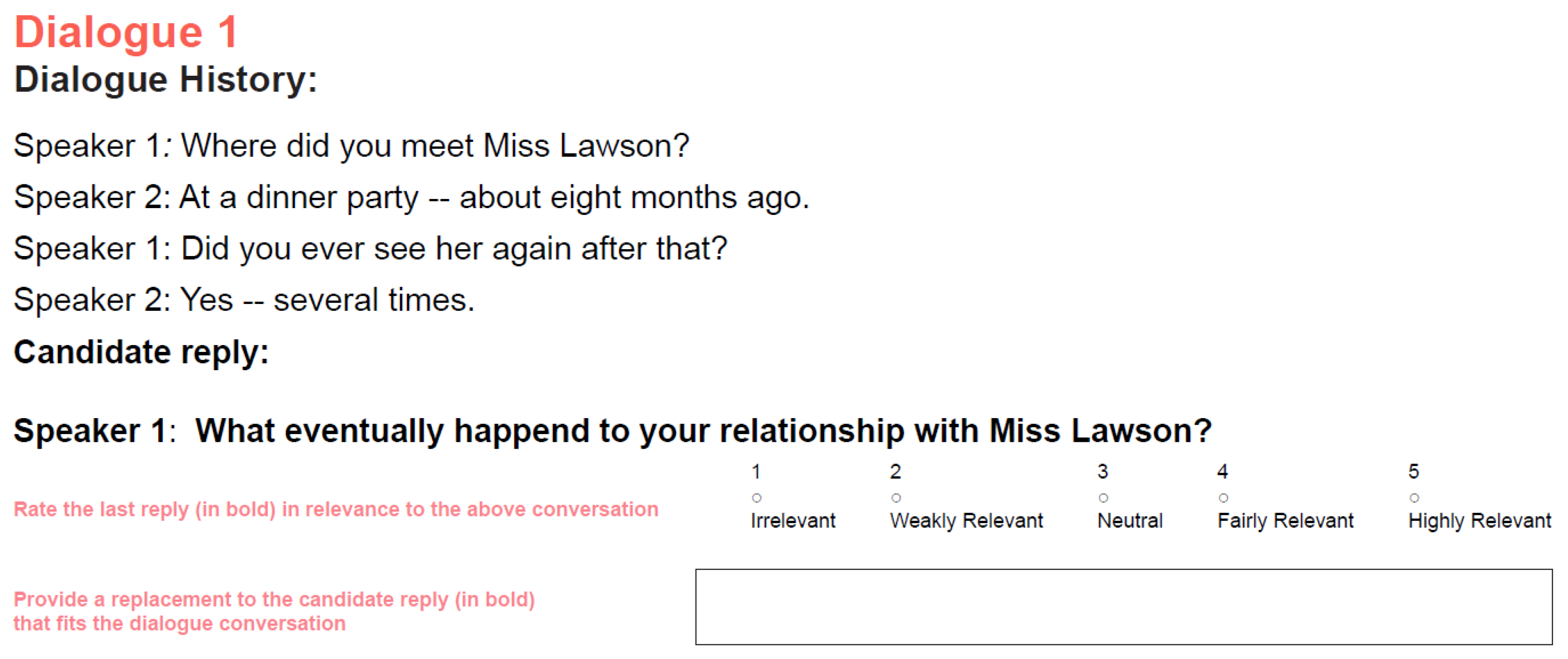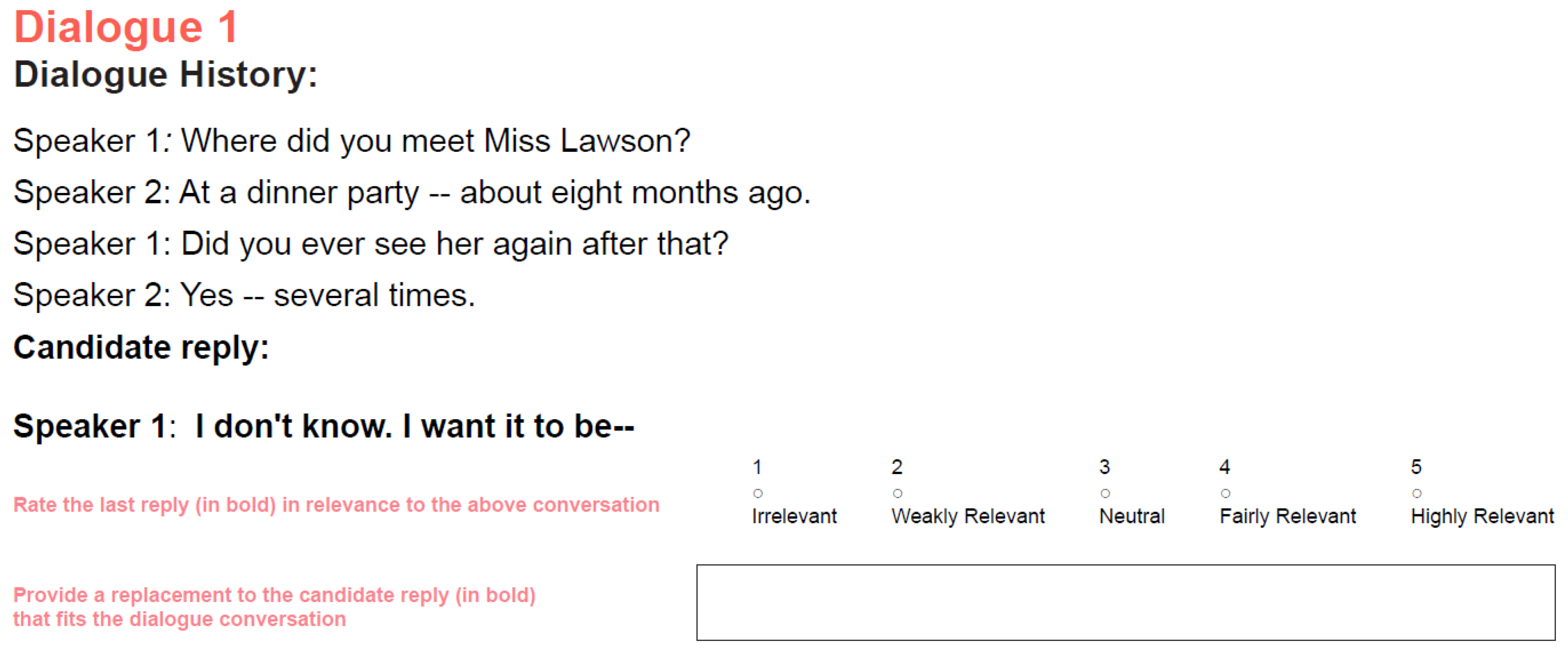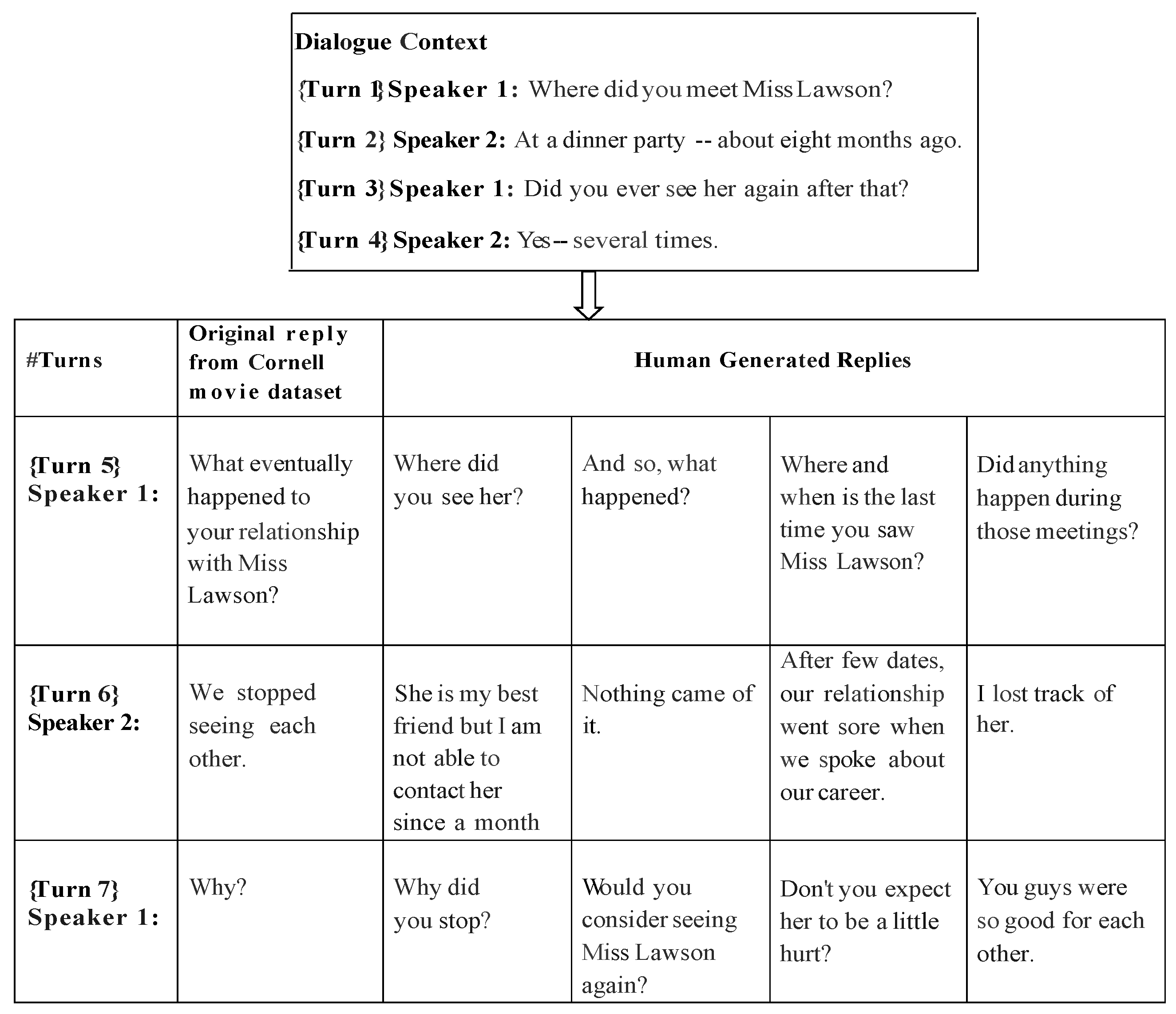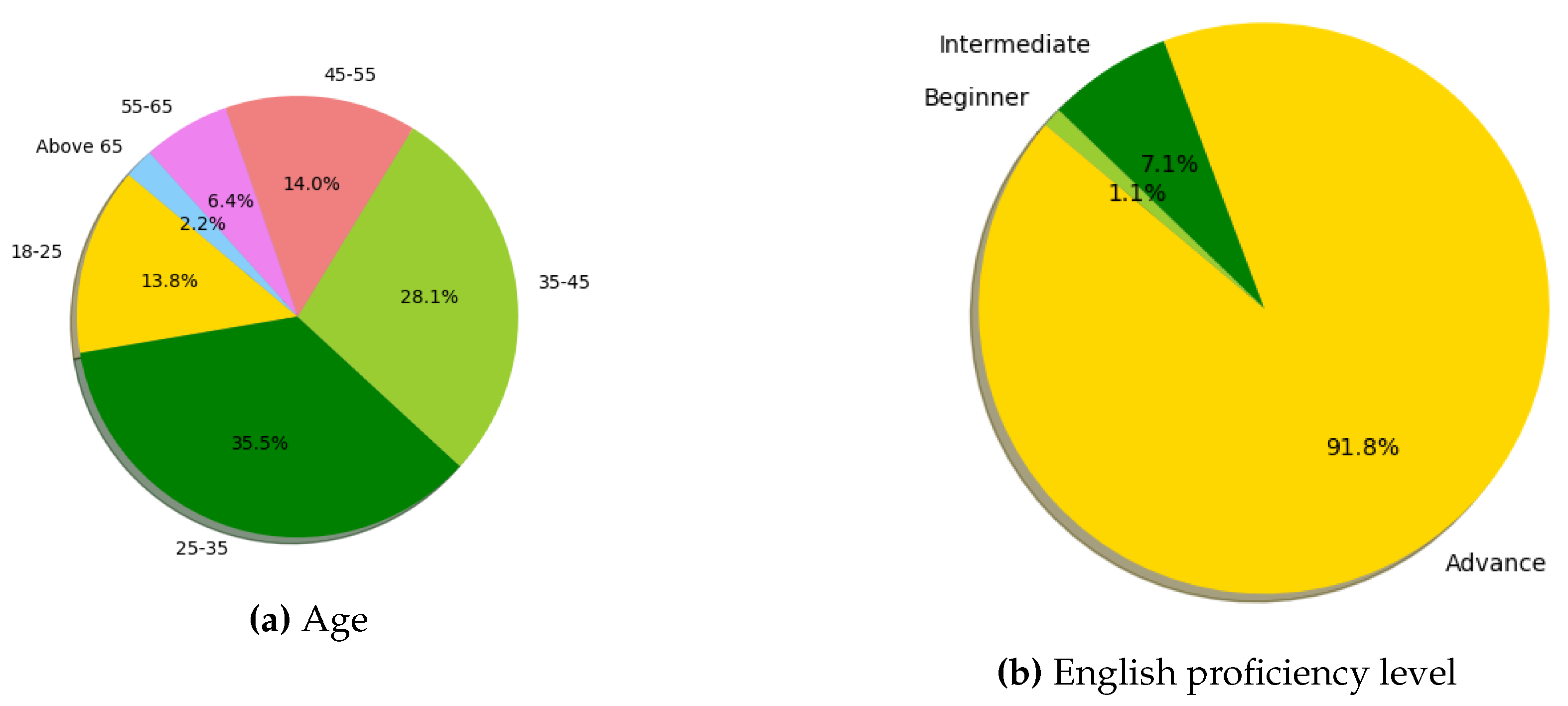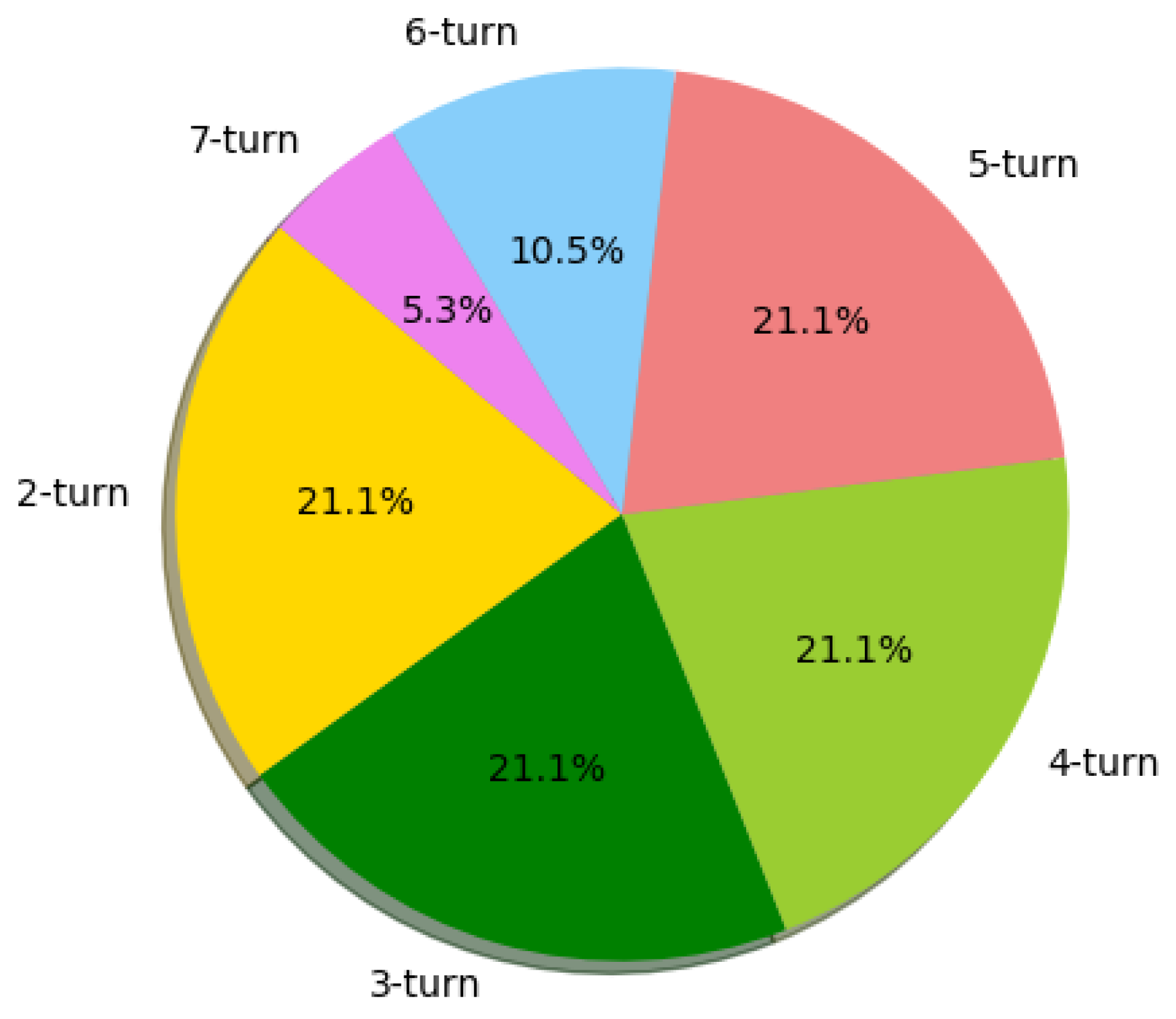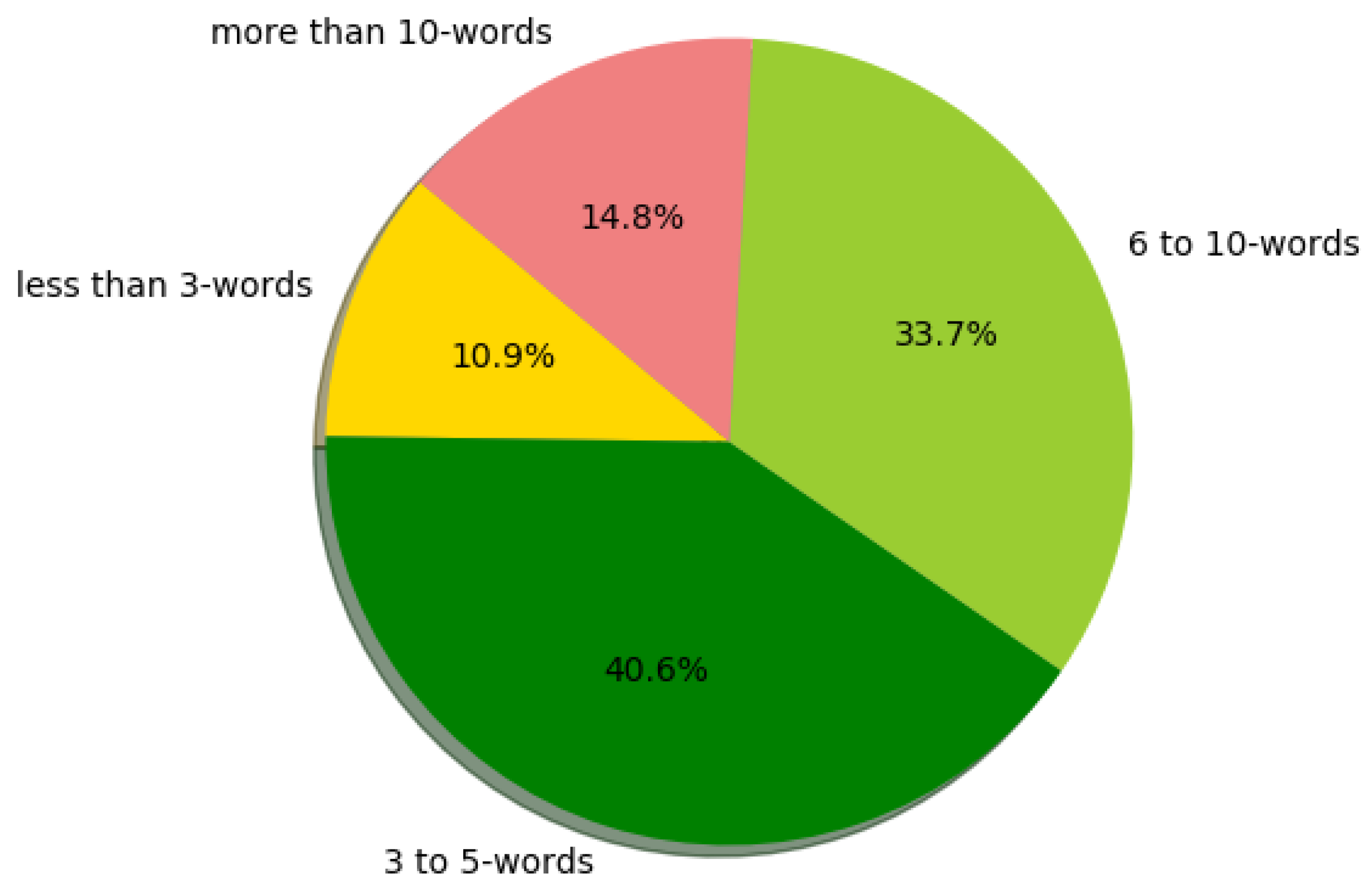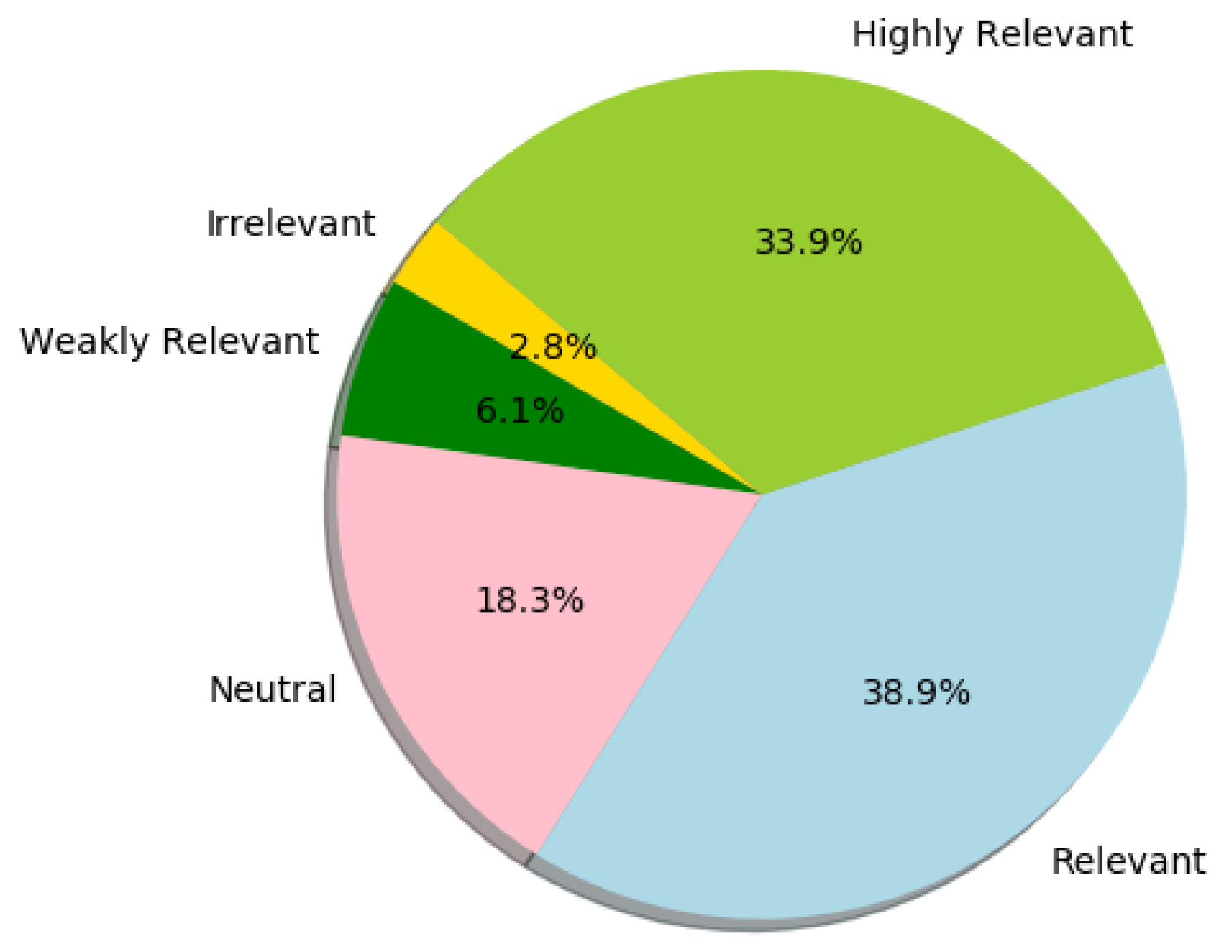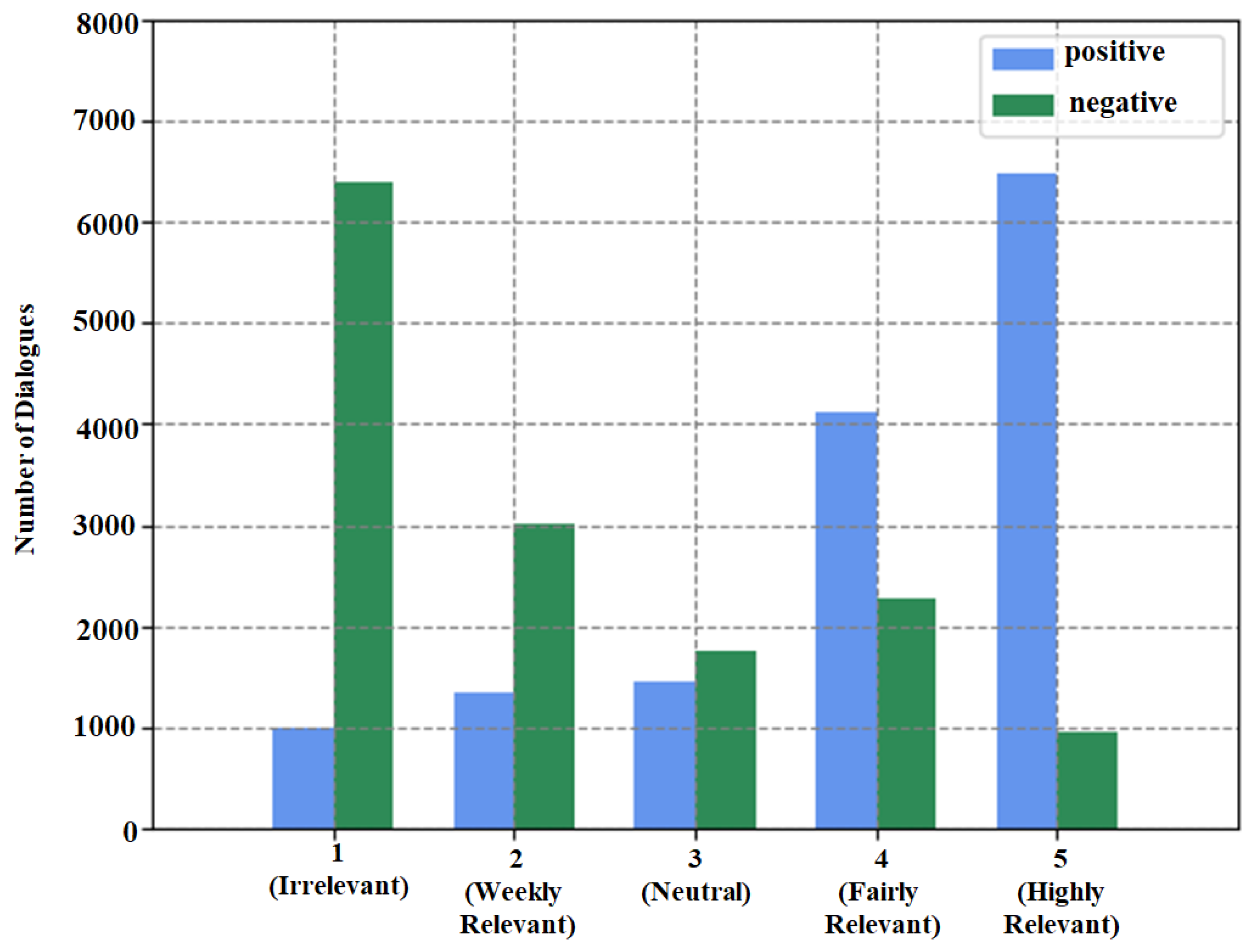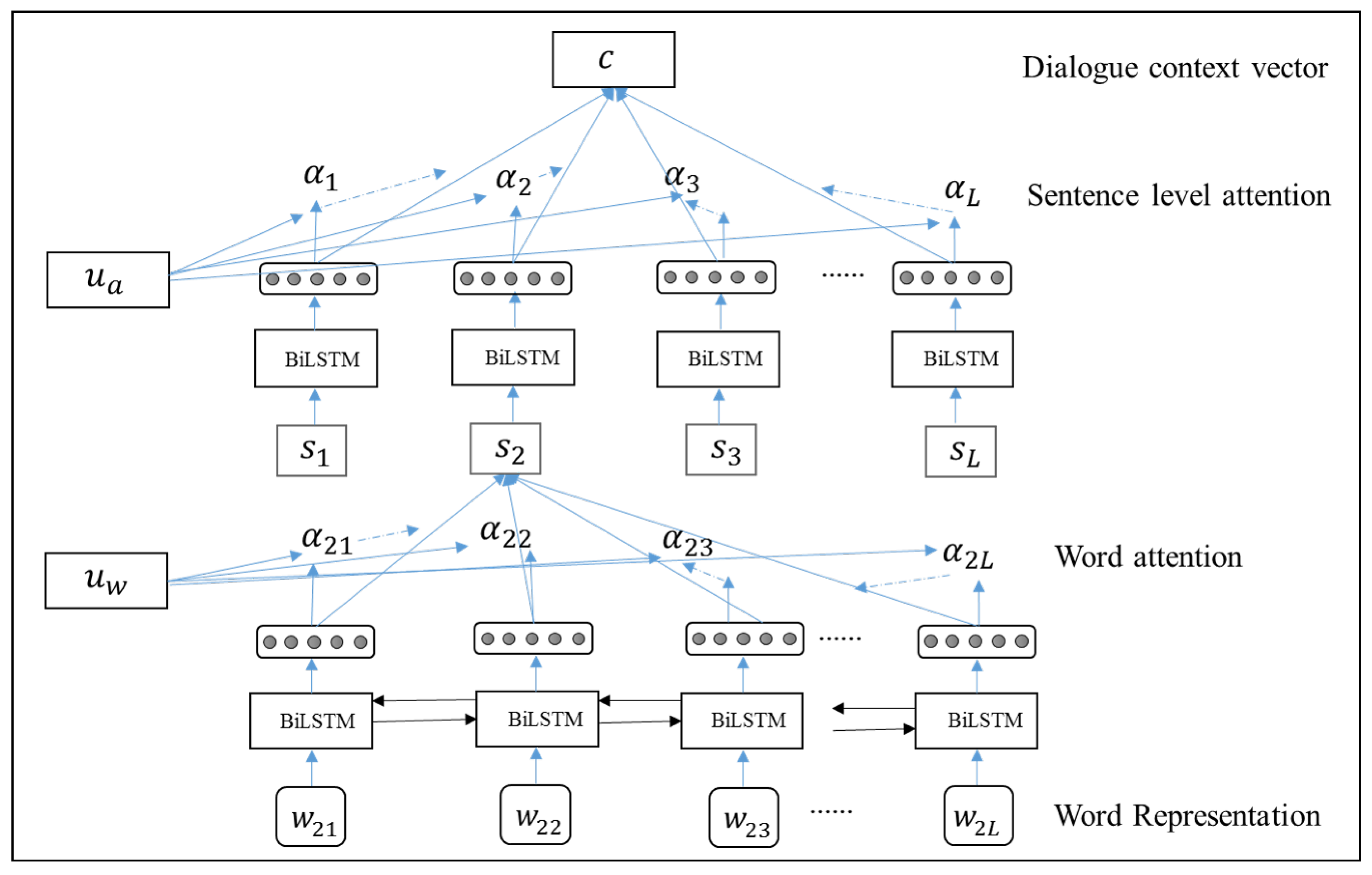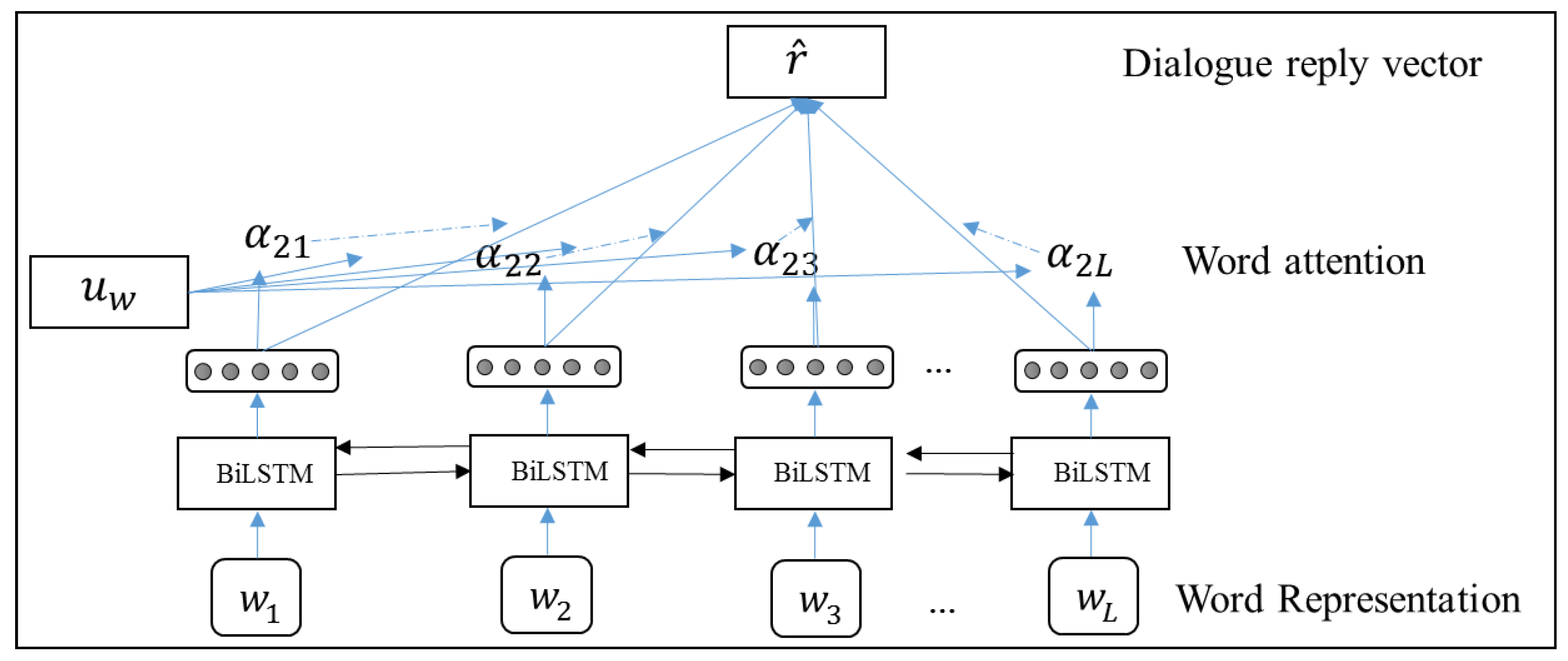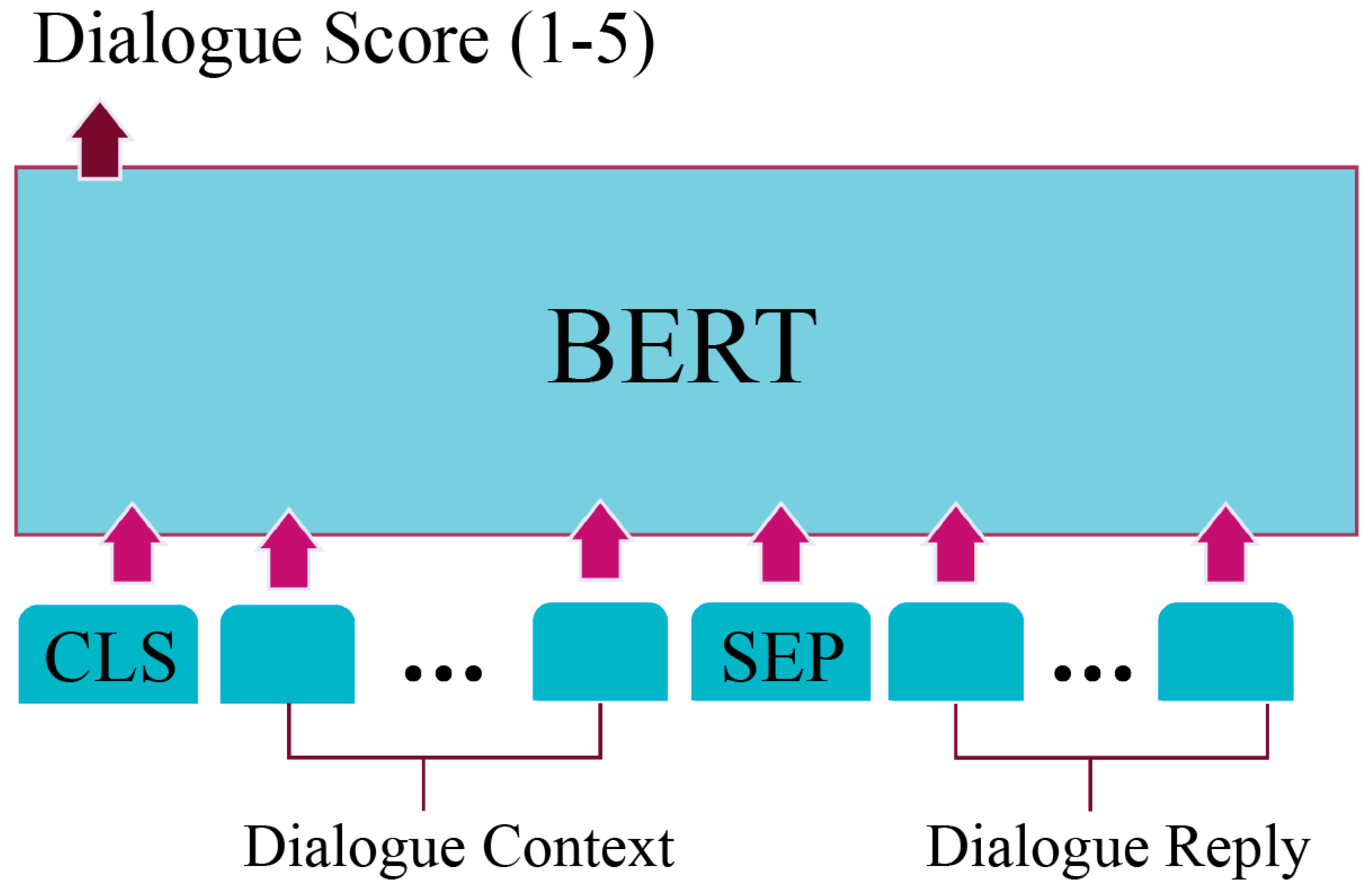1. Introduction
The primary goal of intelligent dialogue systems in real-life applications is to enable efficient communication between humans and computers in a natural and coherent manner. A dialogue system requires a large amount of data to learn meaningful features and response generation strategies for building an intelligent conversational agent. Various methods, including deep learning techniques, have contributed immensely towards building dialogue systems in several real-life application domains such as natural language processing, recommender systems and question-answering systems.
It is still challenging to build a system that can understand the underlying semantics of the user input sequence, and generate coherent and meaningful responses due to limited and domain-specific dialogue datasets [
1]. Previous works have developed variously structured [
2,
3] and unstructured [
4] large datasets to train dialogue managers for the dialogue systems. One major challenge while training a dialogue manager is a lack of benchmark metrics which can be used to measure and compare performance of dialogue managers for non-task-oriented dialogue systems. Furthermore, there is no publicly available dataset with human annotations on the quality of dialogue–reply pairs to develop such metrics.
Dialogue has a certain level of abstraction due to natural language and human knowledge base; in other words, there is a very high response diversity which is unlikely to be captured by a single response [
5]. Therefore, human perception of the dialogue is of utmost importance to provide diverse and unique dialogue replies depending on the dialogue history encapsulating individual’s language, experience, knowledge and writing preferences. In addition, human-generated replies for the given dialogue context will help in developing robust dialogue managers, since it is not feasible to simulate good responses by using only templates. This is required in various domains but in the medical domain generally and in ambient assisted living specifically [
6].
In order to address these challenges, we have developed a high-quality human annotated multi-turn movie dialogue dataset, HUMOD, from a subset of the Cornell movie dialogue dataset [
7]. The collected dataset contains human annotations on fictional conversations of the movie scripts and diverse human generated replies. We have chosen Cornell movie dialogue dataset as our base dataset since it has diverse conversations on a wide span of topics, which are close to human spoken language [
8], thus making the dataset ideal to train open domain dialogue systems. In [
8], it is shown with quantitative and qualitative analyses that movie language is a potential source for teaching and learning spoken language features.
An example from the HUMOD dataset is shown in
Figure 1. The dataset is created such that each dialogue context has two possible replies, similar to [
9]—first is the actual reply of the dialogue context, which we named as positive reply and second is a reply that is sampled uniformly from the set of all possible replies, which is named as the candidate negative reply for the dialogue context. In
Figure 1, a sample of the dataset is presented in three blocks, where the first block shows the 6-turn dialogue context, the second block contains a positive reply (actual reply from Cornell movie dataset) and candidate negative reply (sampled reply) and the third block shows the two human generated replies for the dialogue context. In [
9,
10], training is done using both positive and candidate negative replies as Next, Utterance Classification (NUC). In NUC, candidate replies can also be related to context; therefore, it is important to investigate the relevance of candidate negative reply together with actual reply. The ratings on both (positive and candidate negative) the dialogue replies from 1–5 (1: Irrelevant; 2: Weakly relevant; 3: Neutral; 4: Fairly relevant; 5: Highly relevant) are given by users. Furthermore, there are six (three for positive and three for candidate negative) human-generated replies for each dialogue context. Thus, six unique replies for each context of HUMOD dataset will help in evaluating the models against the provided human responses. The detailed descriptions of the dataset design and collection, analysis, and task formulation are discussed in
Section 3. In addition, we provide benchmark performances of the supervised Hierarchical Attention Network (HAN) [
11] model (with two different loss functions), Bidirectional Encoder Representations from the Transformers (BERT) [
12] model and word-overlap metrics such as BLEU [
13], ROUGE [
14] and METEOR [
15] to analyze the quality of dialogue replies for the given context. The dataset is also publicly available at:
https://github.com/erincmer/HUMOD.
2. Related Datasets
Dialogue systems have been categorized into two groups [
16]: task-oriented systems and non-task oriented systems (also known as chatbots). The aim of task-oriented systems is to assist users to complete specific tasks by understanding the inputs from the user. Manual handcrafted rules in such systems make it not only expensive and time-consuming but also limit the systems to a particular domain. Non-task oriented dialogue systems can communicate with humans on open domains, thus they can be used in real-world applications.
Dialogue systems are mainly task-oriented, designed to complete specific tasks such as airline tickets booking [
17], bus information searching [
18], restaurant booking [
10] or railroad goods shipping [
19]. Such systems perform well when the task is simple and explicit intentions of the users are well-calibrated to the system capabilities. Moreover, some of the popular domain specific datasets are bAbI simulated restaurant booking dialogues [
10], Movie dialog dataset [
20] and Ubuntu Dialogue Corpus dataset [
4]. The Ubuntu dataset consists of large-scale unstructured dialogues with a multi-turn conversation between two persons, where negative turns of the dialogue are created by sampling. Major drawbacks of the Ubuntu dataset are that it has no annotation on context–reply pairs and no different replies for the same context.
Many recent works use conversational models for open-domain datasets such as Twitter Dialog Corpus [
21] and the Chinese Weibo dataset [
22] that are posts and replies from social networking sites. PERSONA-CHAT dataset [
23] introduces chit-chat dialogues between crowd-sourced participants based on their given profile. The DailyDialog [
24] dataset uses manual labeling with three human experts to develop a dataset with communication intention and emotion information. Moreover, the other large-scale datasets that are often used to train neural network-based conversational models are movie-subtitles datasets such as OpenSubtitles [
25], Cornell Movie-Dialogue Corpus [
7], Movie-DiC [
26] and Movie-Triples [
27]. In this work, we selected 4750 dialogues from the Cornell movie dialogue dataset as our base dialogues which are then used for human annotation as explained in the next section. A comparison of the HUMOD dataset with the existing movie dialogue datasets is shown in
Table 1.
In previous works of dialogue response evaluation, different unsupervised metrics have been adopted [
28] to evaluate (or how not to evaluate) dialogue systems with human judgments in the Ubuntu and Twitter corpus dataset. In addition, supervised metrics [
29] have been implemented that are trained to predict human judgments with or without reference reply. In this paper, we perform a correlation of human judgment with both supervised and unsupervised metrics in order to provide preliminary benchmark metrics on the HUMOD dataset.
3. Human Annotated Movie Dialogues Dataset (HUMOD)
3.1. Dataset Design and Collection
We developed a website for data collection and used the crowdsourcing platform Amazon Mechanical Turk (AMT) (Full anonymity of the users were maintained and no ethical concerns were raised by the host institution) for collecting human annotations on selected Cornell movie dialogues. The dataset creation is performed in the following steps: First, we used simple random sampling to select 4750 dialogue contexts from the Cornell movie dataset in which each dialogue is divided into utterances. Since the dataset contains human–human dialogues, we assigned each utterance alternatively as Speaker 1 and Speaker 2 as shown in
Figure 1. The dataset consists of multi-turn dialogues ranging from two to the maximum of seven turns. Then, each dialogue history is appended with an actual reply from the movie dialogue dataset and also with a candidate negative reply which is sampled uniformly from a possible set of replies, thus making the dataset size of 9500. At the beginning, basic demographics of the users were asked including Age range, Gender, and English proficiency level. These demographic variables are collected so that the dataset can be tailored as per the needs and preferences of researchers to develop conversational agents for different demographics. In the next step, each AMT user was given a task of 20 sampled dialogue conversations and was asked to rate the last reply of the dialogue conversation from 1–5, (where 1: Irrelevant reply; 2: Weakly relevant reply; 3: Neutral; 4: Fairly relevant reply; 5: Highly relevant reply) according to the dialog context and provide their relevant reply in replacement to the last reply. The total number of completed tasks were 1425.
Each dialogue–reply pair is rated by three different users, such that, for each dialog context, there are six unique responses, resulting in a total dataset size of 28,500. In order to maintain the high quality responses in the dataset, we selected responses of only those AMT users who have more than 80% hit approval rate. Each task was evaluated by a human expert and low quality tasks consisting of short or generic replies, erroneous replies consisting of gibberish text (user’s reply for given dialogue context), user’s replies in different languages (other than English) and the same ratings given to every dialogue–reply pairs were discarded.
Figure 2 and
Figure 3 present the screen shots from the website, showing how dialogue appears to the users with positive reply and candidate negative reply for the particular dialogue context. Since each task contains 20 randomly selected dialogue context-reply pairs, the chances of the same dialogue context appearing with both positive and candidate negative replies to the same user is very minimal.
The six diverse replies for each dialogue context in the proposed dataset enable the extendability feature of HUMOD dataset. An example with reference to a dialogue context of how the dataset can be extended using human replies is shown in
Figure 4. The seven-turn dialogue of the dataset is divided into two parts. The first part of the figure (upper block) contains the first four turns of the dialogue context and the second part (lower block) consists of all possible replies for the remaining turns of the seven-turn dialogue context. In the lower block, the second column displays the original reply from the Cornell movie dialogue dataset, and the remaining columns show the human-generated replies (four out of six) as a replacement to the original reply. Different combinations of replies in each turn can be used to augment the dataset with the caution of adding some noise. From the example in
Figure 4, we analyze that, with five possible replies in each turn, a total of 125 diverse dialogues can be created, while many of the created dialogues are as coherent as the original one. This extension feature would enable to generate extra data inexpensively, which could help in training generative models to generalize better and learn to provide various replies for the same dialogue context. The extendability assumption comes from the fact that humans generated alternatives replies while being coherent with dialog context. However, it is not very beneficial to perform topic modelling or word commonality analysis since they do not reflect coherence of alternative reply in the given dialog context and only comparing to dialogue ground reply would lead to poor results.
3.2. Data Analysis
This section presents the description of the HUMOD dataset and insights on human annotations. The users’ demographics obtained are shown in
Figure 5. The aim is to achieve human perception towards dialogue across the age groups, and we managed to achieve diversity among users, as shown in
Figure 5a. The gender ratio obtained was 46% of male and 54% female, and users were also not restricted to their geography. The majority of the users (91.8%) were having advanced English level understanding as can been seen in
Figure 5b, which makes the HUMOD dataset of high-quality.
The number of turns per dialogue used in the dataset is given in
Figure 6.
Figure 7 shows the distribution of the number of words among all the obtained dialogue replies from the users.
Figure 8 presents the evaluation of human generated replies on a selected HUMOD dataset. As can be seen from the figure, 2.8% of the AMT users rated Irrelevant, whereas, in the original dataset, the Irrelevant score was around 3.3% for the same dialogue–reply pairs.
Figure 9 presents the histogram of user ratings for positive and negative replies. As can be seen from the figure, positive replies are rated high (4 or 5) by users, about 74% (10,610 out of 14,250) and negative replies are rated low (1 or 2), around 73% (10,404 out of 14,250). It is crucial to take into account the number of low scores in positive replies and high scores in negative replies which introduce noise in the dataset. Thus, it is important to get human judgments even for positive pairs. The negative training data can be even harmful for binary text classification [
30], which may occur in the case of next utterance classification in dialogue settings. Therefore, another approach for training dialogue managers could be Positive-Unlabeled (PU) Learning [
31]. In PU Learning, there is a positive set, and instead of negative there is an unlabeled dataset which can contain positive and negative samples. Existing methods [
31,
32] which perform well in PU Learning problems can also be applied to next utterance classification for dialogues.
The human generated replies of HUMOD dataset are highly relevant since users were asked to provide relevant replies for the given dialogue context during data collection. However, in order to perform initial evaluation on human generated replies, we randomly selected 30 dialogue reply pairs with six diverse replies of different turns (for example, five dialogues for each turn i.e., 2-turn, 3-turn, 4-turn, 5-turn, 6-turn, 7-turn) from the HUMOD dataset. Each diverse reply set is rated by two AMT users. The number of human generated replies for evaluation could be higher with increasing cost, but a strong pattern of relevancy can be easily seen in these sampled human generated replies.
To evaluate human agreement on their responses with each other, we calculated weighted Cohen’s kappa score [
33] between human ratings. We calculated weighted kappa score for different configurations of three ratings for each dialogue context and reply pair. From the three ratings of each reply, we calculated weighted kappa score for the closest two (as a majority voting) ratings, the highest two ratings, the lowest two ratings, and on the random selection of two ratings. For example, if a dialogue context-reply pair is rated (5, 4 and 1), we keep the closest two (5 and 4) and randomly assign them to Rater 1 and 2. Results for all different configurations can be seen in
Table 2.
3.3. Task Formulation
We provide a benchmark performance with supervised models and word-overlap metrics on the proposed HUMOD dataset. The task formulated is to predict human ratings for given dialogue history–reply pair from Irrelevant (1) to Highly-relevant (5). The dataset will enable researchers to test their dialogue reply metrics against human ratings.
4. Methods
This section provides details about the supervised models and word-overlap metrics, which are used to predict the human scores for dialogue replies. For supervised models, a network inspired from hierarchical attention networks (HAN) is designed as shown in
Figure 10. Recurrent Neural Network (RNN) based models are implemented in a way such that it does not require a reference answer, since it makes them more applicable but difficult to train in comparison to the models which uses reference response. Our model is the same as the Automatic Dialogue Evaluation Model (ADEM) [
29] model with an additional attention layer. In ADEM, training and evaluation was performed with and without reference reply. Although ADEM results without reference reply is lower in comparison to with the reference reply, we preferred to train without a reference as it is not practical to have reference reply in real life applications. In addition, we used a Bidirectional Encoder Representations from Transformers (BERT) supervised model for comparison with HAN and word-overlap metrics. Word-overlap metrics require reference answers unlike supervised models and only use reference reply without any context information, which makes them perform poorly. These metrics are easy and inexpensive to run without the need for training and can be applied as long as there is a reference text. Supervised models require training to predict the dialogue reply score which makes it difficult to generalize and expensive to use in different domains and tasks. We used metrics such as BLEU [
13], METEOR [
15] and ROUGE [
14], where the first two are used widely in translation and the last one for assessing the quality of the summarized text.
4.1. BLEU
BLEU [
13] score calculates the precision of n-grams of machine-generated dialogue replies in human replies. Often, the brevity penalty is used to avoid short sentences. From different n-gram choices, the most common one is n = 4 where the weighted average of different BLEU (1 to 4) scores are used to evaluate the machine-generated replies. BLEU first calculates a modified precision score for each n-gram length as below:
where
represents all possible n-grams of length n in hypothesis sentences. Later,
To avoid shorter sentences, the modified precision score is often multiplied with a brevity penalty to achieve the final score.
4.2. ROUGE
The ROUGE [
14] score originally calculates the recall of n-grams of human dialogue replies in machine-generated dialogue replies. ROUGE can be extended to ROUGE-L, which is a combination of recall and precision ROUGE scores based on longest matching sequence (LCS). LCS only requires sentence level word order matches and it allows other words to appear between words of LCS. LCS does not need n-gram to be predefined:
4.3. METEOR
METEOR [
15] score aligns human generated reply and machine-generated reply. This alignment is done word by word with an order of exact match, Porter stemming match or WordNet synonym match. It computes the parametric harmonic mean (
) between unigram recall and unigram precision:
where
t and
r are the total numbers of unigrams in the translation and the reference.
m represents the number of mapped unigrams between reference and hypothesis sentences. Penalty term (
) is computed so that it takes into account matched unigrams between hypothesis and reference that are in the same order.
4.4. Hierarchical Attention Network-Based Models
In this work, we implemented two separate networks, one for dialogue context and another for the dialogue reply. Context encoder is a Hierarchical Attention Network (HAN) [
11] as shown in
Figure 10. It encodes dialogue context to a dialog context vector
c. Reply encoder network is a biLSTM [
34] network with attention mechanism on top to convert reply to a reply vector
(
Figure 11).
We implemented two different loss functions after the dialogue context and reply are encoded to vector representation. The first loss is the cross-entropy loss which classifies concatenated vectors of dialogue context and reply into five classes (1–5):
where
h represents average human scores,
c represents the context and
is reply vector.
is the fully connected layer which outputs the score for the given context and reply.
Second loss, as in Equation (
11), is trained with mean squared error against human score and uses a concatenated vector. We did not use cosine similarity between dialogue context and reply since the authors in [
35] showed that ADEM, which is similar to ours, creates response embedding with very low vector spread in the embedding space. In dialogue, there are many alternative replies for the same context, and the same reply can be a good fit to very different contexts and common replies that occur a lot and fit to a lot of different contexts. Due to these observations, when a dialogue manager is trained using cosines distance and make embedding of context and reply similar, eventually very different texts become similar and may collapse to very small region in embedding space.
4.5. Bidirectional Encoder Representations from Transformers (BERT)
BERT [
12] is a bidirectional language model that allows models to learn both left and right context in all layers. BERT is pretrained with two novel methods that are “Masked Language Model (MLM)” and “Next sentence prediction” and uses Transformer [
36] with attention instead of recurrent networks like LSTM. The Next sentence prediction method is more related to our task since it trains BERT to learn the relationship between sentences, which may improve performance in case of dialogue context and reply scoring. The BERT model has achieved state-of-the-art performance on various Natural language processing (NLP) tasks and also outperformed human performance in question-answering tasks. Therefore, we fine-tuned BERT (from tensorflow-hub) on the HUMOD dataset as shown in
Figure 12 in order to compare performance with other approaches. As can be seen from
Figure 12, BERT takes input as tokenized dialogue context and dialogue reply separated with SEP token and outputs a final vector representation of dialogue context and reply pair. Later, this vector is classified to a relevance score of 1–5 with additional dense layer on top of BERT.
5. Experiments
We performed a comparison of supervised and word-overlap metrics to see how they are correlated with human judgments. The dataset is divided into 8500 context-reply pairs for the train set and 1000 context-reply pairs for the test set.
No dialogue context is shared between train and test set. Since for each dialogue we have scores of three judges, we took the average score of three judges. Both supervised and word-overlap approaches are evaluated on the same test set. For word-overlap metrics, we normalized average human scores into the 0–1 range and calculated metrics using the NLGEval toolkit [
37]. Both the context encoder and the reply encoder use 50-dimensional GloVe word vectors [
38], and the dimension of 100 was chosen for each biLSTM hidden state for the HAN-based model. For the model which uses BERT, input is constructed as dialogue context and dialogue reply separated with a special token, and the final encoded vector is classified into one of the five classes.
6. Empirical Results
The preliminary results of HUMOD dataset with existing supervised and word-overlap metrics is shown in
Table 3.
We provided the benchmark results for the overall correlation of human judgment with different models. Although supervised models are correlated up to some degree, it is still far from applicable to use in dialogue reply scoring as widely as translation scores are used to evaluate machine translation models both in terms of human correlation and ease of use.
As can be seen from
Table 3, the BERT model outperformed the word-overlap metrics and HAN model. Since the BERT model takes advantage of the language model and can be fined-tuned according to other dataset, in this experiment, we used BERT with pretrained weights and fine-tuned it for the HUMOD dataset, which may explain the performance difference of supervised models. In addition, correlation of BERT with human judges is performed to investigate the behavior of the network against different dialogue turns (shown in
Table 4). We tested BERT performance on different turn dialogues to see how context length affects the performance of dialogue measure. 2-turn dialogues correlation is found to be lowest, which can be due to hardness to evaluate the dialogue reply score for very short dialogues since it contains very little context, which may increase humans’ own judgement and bias. Similarly, for long-dialogue conversation, it is slightly harder for the system to contain the context and make a good understanding of the fitness of dialogue context and reply pairs.
7. Conclusions and Future Work
This paper presents the human annotated movie dialogue dataset (HUMOD) for research to develop benchmark metrics for comparison of different models on human scores and generated replies. The detailed description of the dataset construction and statistics is provided. The availability of the HUMOD dataset opens up various possibilities for research and development of complex dialogue systems for real-life applications. Different replies for the same context as well as dialogue ratings can be used to develop a metric to compare methods such as BLEU. Another interesting usage of a unique diverse reply is to train generative models that generate diverse dialogue replies which may make dialogue managers more human-like in real-life applications. We present the preliminary results to provide baselines with supervised and word-overlap metrics. HAN provides better results in comparison to word-overlap metrics since these approaches do not use any context. The BERT model outperforms the HAN model and provides good correlation on the human dialogue score; however, it is harder to train and requires fine-tuning for each different dataset.
In future work, we will work on a metric that uses dialogue contexts and replies to produce a robust score without any training. We will also focus on generative models that can leverage all possible replies for a given context rather than a single context–reply pair. Another interesting approach is to generate diverse replies from single context–reply pairs and to use such created data as augmentation for dialogue managers. All this is relevant for the upcoming research stream of explainable AI, where NLU [
39] plays a particular role, e.g., in the generation of human-understandable explanations [
40,
41], where it is very useful for the development of future human-AI interfaces.
